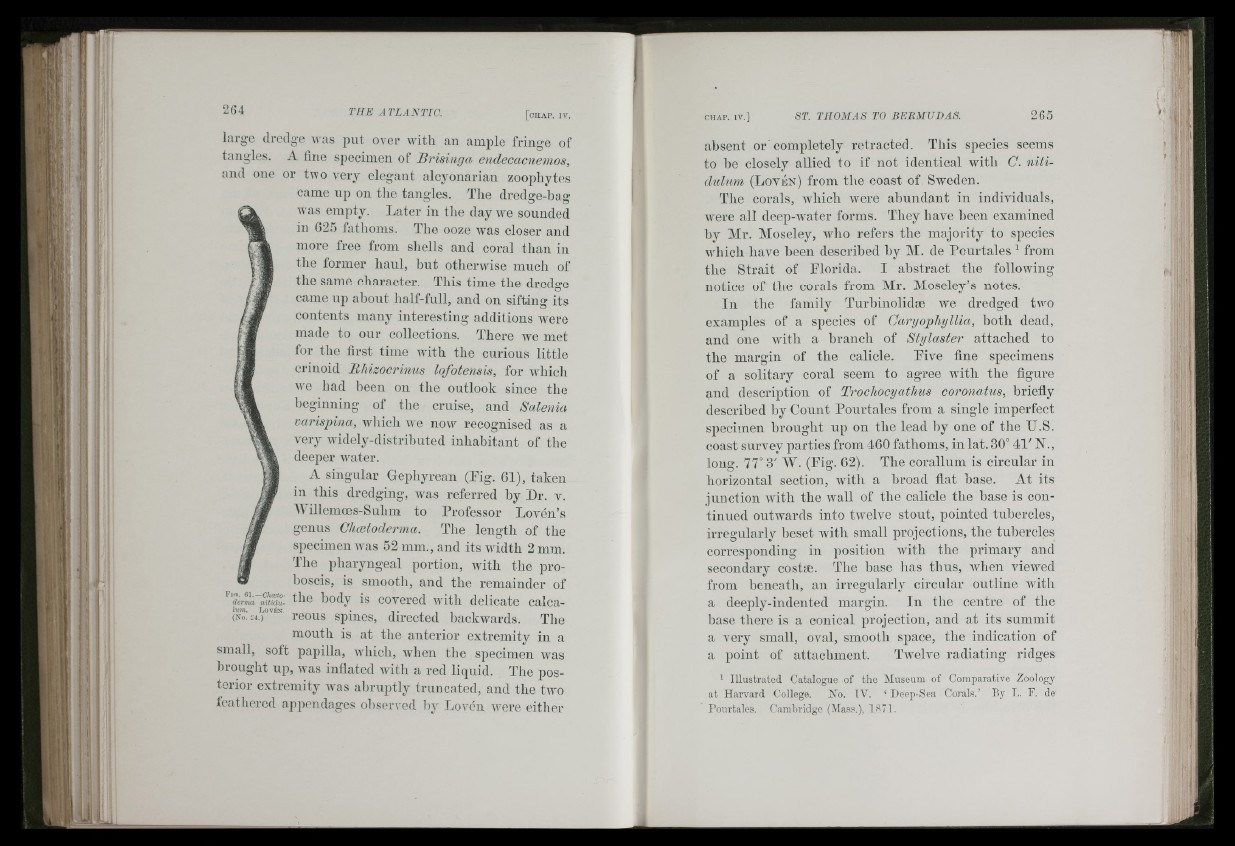
l i t ■ '
L..,
F n .
large dredge was jnit over with an ample fringe of
tangles. A fine specimen of Brisinga endecacnemos,
and one or two very elegant alcyonarian zoophytes
came up on the tangles. The dredge-hag
n as empty. Later in the day we sounded
ill 625 fathoms. The ooze was closer and
more free from sliells and coral than in
tlie former haul, but otherwise much of
the same character. This time the dredge
came up ahout half-full, and on sifting its
contents many interesting additions were
made to our collections. There we met
for the first time Avith the curious little
crinoid Rhizocrimis lofotensis, for Avhich
Ave had been on the outlook since the
beginning of the cruise, and Salenia
varispina, wliich Ave now recognised as a
very Avidely-distributed inhabitant of the
deeper water.
A singular Gepliyrean (Lig. 61), taken
in this dredging, Avas referred by Dr. v.
WillemcEs-Suhm to Professor Loven’s
genus Chcetoderma. The length of the
specimen Avas 52 mm., and its width 2 mm.
The pharyngeal portion, with the proboscis,
is smooth, and the remainder of
d e rm a n i t i d u : the body is covered Avith delicate calcah
n n , L o v 6 n , • . , 1 1 -, (No.24.) reous spines, directed haclvAvards. The
mouth is at the anterior extremity in a
small, soft papilla, Avhich, when the specimen Avas
brought up, Avas inflated with a red liquid. The posterior
extremity Avas abruptly truncated, and the tAVO
feathered appendages observed hy Loa-ou Avere either
absent or'completely retracted. This species seems
to he closely allied to if not identical Avith C. niti-
dulum, ( L o v e n ) from the coast of Sweden.
The corals, Avhich Avere abundant in individuals,
Avere all deep-Avater forms. They have heen examined
by Air. Aloseley, Avho refers the majoilty to species
Avhich have been described hy AI. de Pourtales ^ from
the Strait of Llorida. I abstract the folloAving
notice of the corals from Air. Aloseley’s notes.
In the family Turhinolidse Ave dredged two
examples of a species of Caryophyllia, both dead,
and one Avith a branch of Stylaster attached to
the margin of the calicle. Pive fine specimens
of a solitary coral seem to agree with the figure
and description of Trochocyathus coronatus, briefly
described hy Count Pourtales from a single imperfect
specimen brought up on the lead hy one of the U.S.
coast survey parties from 460 fathoms, in lat. 30° 41' ~N.,
long. 77° 3' W. (Lig. 62). The corallum is circular in
horizontal section, witli a broad fiat base. At its
junction Avith the wall of the calicle the base is continued
outAvards into tAvelve stout, pointed tubercles,
irregularly beset Avith small projections, the tubercles
corresponding in position Avith the primary and
secondary costie. The base has thus, Avhen vieAved
from beneath, an irregularly circular outline Avith
a deeply-indented margin. In the centre of the
base there is a conical projection, and at its summit
a very small, oval, smooth space, the indication of
a point of attachment. TVeUe radiating ridges
’ Illustrated Catalogue of the Museum of Comparative Zoology
at Harvard College. No. IV. ‘ Deep-Sea Corals.’ By T.. F. de
Pourtales. Cambridge (Mass.), 1871.
•; ■ i i/irrf ;I ?:
:1 |